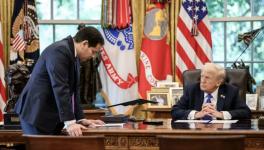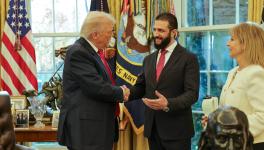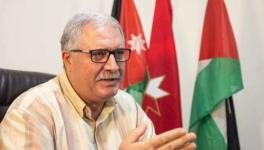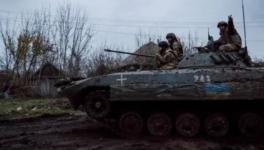As Protests Against Neoliberal Policies Rage in Iran, Trump’s Cartel Eyes Regime Change
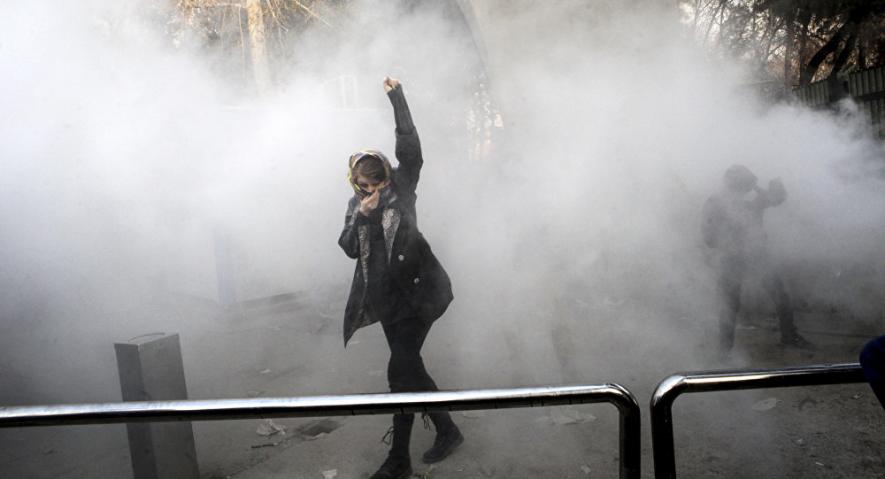
After months of Twitter barrage on North Korea, US President Donald Trump’s Twitter handle has opened a new war front on Iran. As thousands of Iranians continue to protest against increasing unemployment, wage issues, and rising prices in the country, hawks are eyeing for a regime change.
“Oppressive regimes cannot endure forever, and the day will come when the Iranian people will face a choice”, said Trump in a tweet.
According to the state television, around 16 people were killed across Iran as some armed protesters tried to take over police stations and military bases but faced serious resistance from security forces. Fresh protests have begun in Birjand in the east, Kermanshah in the west and Shadegan in the far south-west.
Considered to be one of the biggest after the 2009 mass demonstrations, the anti-government protests were meet with pro-government rallies across Iran. Iranian President Hassan Rouhani, a reformist, appealing for calm said that ‘people have the right to criticize the government and even protest’, but they should not destroy property.
The wave of protests, termed by many as “Eteraz-e-omomi” (or “the general strike” in Farsi), contrary to reports of an ‘unexpected rebellion’, had been simmering since last few months due to economic hardship and rising disparities. As seen in countries across the world in backlash against failed neoliberal and capitalist economic policies, Rouhani’s neoliberal policies with its neglect of the social welfare system have produced the same political effects.
In July this year, Mohammed Mukhaber, a senior Iranian regime official warning about imminent “social and security-related disasters” said, “the situation in Iran has reached a dangerous level, where we have 12 million people living below the absolute poverty line and 30 million citizens living below the relative poverty line.”
But the protest, as some observers put, is a complex jigsaw puzzle. While economic factors dominate the demonstrations, protesters were also heard chanting ‘anti-Palestine’ and ‘pro-Raza Shah’ slogans – bringing back the horrors of 1953 Iranian coup. The US Central Intelligence Agency (CIA) backed coup in 1953 overthrew the democratically elected government of Prime Minister Mohammad Mosaddegh in favour of dictatorship monarchical regime of Shah.
Rouhani’s Neoliberal Push
The resentment against the economic policies spearheaded by the current president Rouhani had been growing for long. Rouhani led government is considered to be culturally ‘moderate’, implementing the highly monopolized neoliberal economic model.
Iran has the world’s fourth-largest oil reserves, 9.3 percent of the total, and the majority of the world’s gas reserves - 18.2 percent of the total. The country also ranks first in the world in sales of saffron, pistachios, pomegranates and caviar.
According to a report, in 2016, the economy saw a strong oil-based bounce back, with an 'annual headline growth rate of 13.4 percent, compared to a contraction of 1.3 percent' in 2015. As the sanctions were relaxed with the Iran nuclear deal in 2015, the largest 'contribution to growth was from the industry sector' (at about 25 percent) as oil and gas production increased by a staggering 62 percent, the report notes.
But despite huge oil revenues, Rouhani led government’s economic policy was based on the pillar of austerity. Western sponsored saction on Iran further exacerbated the austerity measures.
Cutting down on welfare policies (except health services), austerity measures and privatization of education had been priorities of the government, at the same time as heavily increasing the budget allocation for defence. Under Rouhani’s regime, the defence budget saw an increase by 145 percent.
“The politico-economic crisis of the bankrupt theocratic regime of Iran is growing and deepening daily”, noted a statement by the left wing Tudeh Party of Iran. “The heads of the regime who are living a luxury life with an unprecedented fortune that they have amassed over the last forty years by plundering the national resources and wealth of the nation”
The new budget introduced by the government cuts back on subsidies for the poor Ahmedinejad had introduced, which according to many will increase prices for fuel and basic foodstuff up to 30-40%.
Though the GDP growth has registered an increase of 5 percent, the unemployment rate is at 31.9 percent and equally disturbing are the rates of poverty and social inequality. Iran’s official figures argue that 5-6 million Iranian university graduates are out of work. Privatization of education system and universities has intensified since the summer of 2014- a move that faced stiff resistance from students.
Iran is one among the few countries where all the mainstream parties- conservatives and moderates- support privatization and a capitalist economy, but differ only on the speed and scope of privatization.
“They were all capitalist administrations with semi-governmental monopolies. All these administrations were basically opposed to any effective form of welfare, scientific planning or democratic and cooperative programs that would increase equality”, said a prominent left-wing Iranian economist, Fariborz Raisdana, who was arrested and jailed in 2012 for criticizing changes in subsidy payments. He further added, “for all of them, making more profit by relying heavily on petroleum revenue, heavy capital investment, trade and real estate has always been the number-one goal.”
A look at the Rouhani’s book, National Security and Economic System of Iran, provide evidence about where his policies are rooted in. In his book, he argues that that ‘the minimum wage must be slashed’ and restrictions on the laying off of workers eliminated for Iran’s ‘owners of capital’ to help flourish the country’s economy. He notes “one of the main challenges that employers and our factories face,” Rouhani writes, “is the existence of labour unions. Workers should be more pliant toward the demands of job-creators”.
The Rouhani led government is termed as country’s ‘new elite’ by many critics, who blame the government of corruption and argues “they are more concerned about purchasing aircraft from Airbus and Boeing than creating jobs for the army of Iranian unemployed youth”.
The deep level of poverty, disparity, inflation and high rate of unemployment, along with the corruption among Rouhini’s club had led ‘complete economic bankruptcy of the regime’.
The West imposed sanctions against Iran’s nuclear program, and the US and Israel’s meddling in the internal affairs of Iran has further worsened the economic situation in the country.
The Regime Change Hawks
As protests rage in the country, the hawks of regime change in Iran-US, Israel and Saudi Arabia- are all over the country again, and in Trump’s word, “are watching’. Since the conservative Donald Trump regime took over the presidency in the United States, the policy of not engaging in regime change in Iran by Obama took a backseat.
According to a report, the CIA has recently established a new cell focusing on Iran to expand its operation in the country, which is considered to a ‘major threat’ by US and Israel. The cell reflects Trump’s decision to make Iran a higher priority for American spies. The aim of Iran Mission Center is to bring together operational personnel and analysts from across the CIA ‘to bring to bear the range of the agency’s capabilities’, including covert action.
In December 2017, a secret meeting was held in the White House between US and Israel and an agreement was signed to step up diplomatic and convert operations to deal with all aspects with respect to Iran. This comes after Trump decertified the Iran nuclear deal in October.
Iranian officials have already accused the Saudis of fomenting the protests in the country and blamed “takfiri groups” (Sunni extremists) and “foreign intelligence services”,referring to Riyadh. Saudi Arabia along with the US had been accusing Iran of supplying ballistic missiles to Houthi rebels in Yemen, which Iran denies. The rebels in Yemen had earlier launched two missiles towards Saudi Arabia. The new crown prince, Mohammed Bin Salman, who had recently purged his own relatives and staged ‘kidnapping-cum-resignation’ of Lebanese Prime Minister has vowed in the past “to take the fight to Iran”
As journalist Simon Tisdall puts it- like birds of prey circling high in the desert sky Iran’s rivals are watching the protests with beady-eyed anticipation. The ‘anticipation’, according to many brings back the horrific memories of 1953 CIA orchestrated coup which overthrew the democratic government and placed the US supported dictatorship regime of Shah in power till the 1979 Islamic revolution.
Any such move to bring regime change in Iran through covert operations will destabilize and plunge the whole region into dark times. The British and US invasion of Iraq in 2003 is a living example of such a catastrophe.
The heads of state of Iran's rivals the have ‘displayed unabashed glee at Iran's domestic unrest’. Critics argue that anti-government elements like People's Mojahedin Organization of Iran (PMOI) are trying to overtake the protests. PMOI, also known as Mojahedin-e Khalq have significant lobbying power in Washington and is widely considered to enjoy the backing of Riyadh.
The left-wing forces in the country, many of which are banned by the government have appealed for reshaping the current politically conservative and neoliberal economic structure of the country, at the same time warning against any foreign intervention by the ‘imperialist’ countries.
Meanwhile, as the ‘complex’ protest rages, Rouhani government has taking caution it its response. It is still unclear what is the direction and bearing of these protests and what does it mean for the future of Iran.
Get the latest reports & analysis with people's perspective on Protests, movements & deep analytical videos, discussions of the current affairs in your Telegram app. Subscribe to NewsClick's Telegram channel & get Real-Time updates on stories, as they get published on our website.













